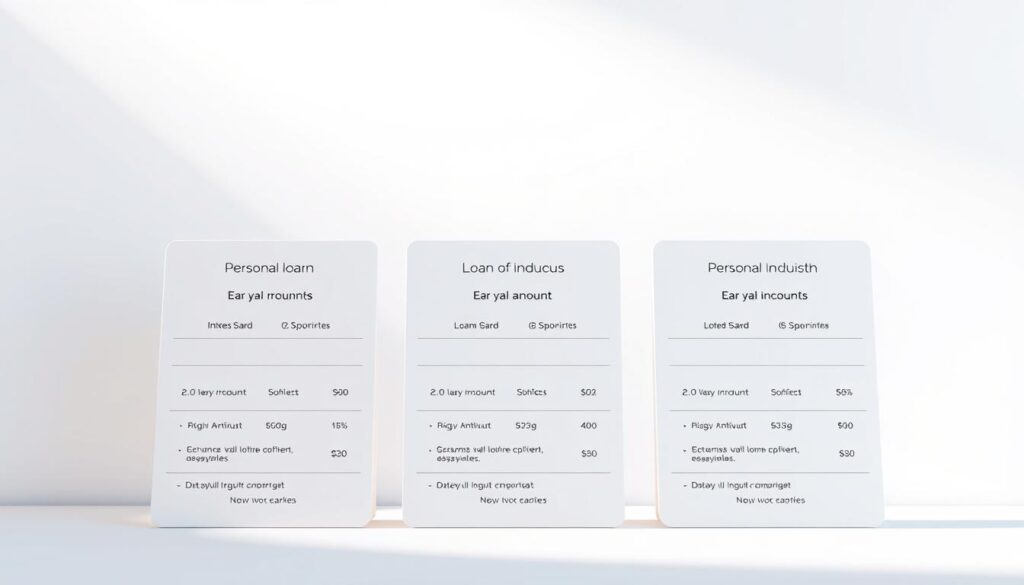Discover the Best Personal Loans for Your Needs
Did you know over 26 million Americans got a personal loan in 2022? The average loan was about $8,000. This shows how many people use unsecured lending options for different financial needs.
A personal loan is a quick way to get money from banks, credit unions, and online lenders. It’s useful for many things like paying off debt, buying something big, or dealing with unexpected costs. Knowing your loan options is very important.
We’ll dive into the world of personal loans. We’ll see how they work and how to pick the best one for you.
Key Takeaways
- Personal loans are a popular financial tool for various needs.
- The average personal loan amount is around $8,000.
- Options are available from banks, credit unions, and online lenders.
- Understanding loan options is key to making informed decisions.
- Personal loans can be used for debt consolidation, large purchases, or unexpected expenses.
What Are Personal Loans?
Personal loans are a flexible financial option. They are unsecured, meaning you don’t need to put up collateral. You can use the money for many things.
Understanding Personal Loans
Personal loans are a versatile financial tool. They can be used for many things, like paying off debt or buying something big. They don’t need collateral, making them easier to get for many people.
Key characteristics of personal loans include:
- Unsecured nature, eliminating the need for collateral
- Flexibility in usage, allowing borrowers to address various financial needs
- Fixed repayment terms, providing clarity on the loan duration and monthly payments
Types of Personal Loans
There are many types of personal loans. They meet different needs and financial situations. Some include:
- Unsecured personal loans, which are not backed by collateral
- Quick personal loans, designed for urgent financial needs
- Online personal loans, which offer the convenience of digital application and processing
How Personal Loans Work
When you apply for a personal loan, the lender checks your credit. They decide the loan’s interest rate and terms. If approved, you get the money and pay it back over time, usually with interest.
As financial experts emphasize, “Personal loans can be a valuable resource for managing finances effectively, provided they are used responsibly.”
Knowing how personal loans work and the types available helps you make smart financial choices.
Benefits of Personal Loans
Personal loans have many benefits, making them a good choice for people with financial challenges. They offer flexibility in how you use the money.
Flexibility in Usage
Personal loans are very versatile. You can use the money for debt consolidation, home improvements, or unexpected expenses. This flexibility is a big plus, as it lets you handle your finances your way.
For example, if you want to consolidate debt, a personal loan can help. It can combine your debts into one loan with a lower interest rate and one monthly payment. This can make your finances simpler and save you money on interest.
Competitive Interest Rates
Personal loans also have competitive interest rates. When looking at loan options, the interest rate is key. It affects the loan’s total cost. Some lenders offer low interest personal loans that make borrowing cheaper.
To understand better, let’s compare interest rates from different lenders.
| Lender | Interest Rate Range |
|---|---|
| Lender A | 6.99% – 12.99% |
| Lender B | 5.99% – 15.99% |
| Lender C | 4.99% – 10.99% |
Fixed Repayment Terms
Personal loans usually have fixed repayment terms. This means you’ll know exactly how much to pay each month and for how long. This helps with budgeting and planning, as you’ll know your financial obligations.
Fixed repayment terms offer stability and predictability. They make it easier to manage your finances and avoid surprises.
How to Qualify for a Personal Loan
Understanding the loan application process is key. Lenders have certain requirements for borrowers to get a loan.
Credit Score Requirements
Lenders look at your credit score when you apply. A high score shows you’ve paid back loans on time. Most lenders want a score of 700 or more. But, some offer bad credit personal loans for lower scores, with higher interest.
To boost your loan chances, keep your credit score up. Pay bills on time, use less of your credit, and check your report for mistakes.
Income Verification Process
Lenders check your income to make sure you can pay back the loan. They ask for things like pay stubs, bank statements, or tax returns.
To get a personal loan, show you have a steady income. Lenders might want you to make at least $25,000 a year. They might also look at your household income or other income sources.
Other Eligibility Criteria
Lenders also check your debt-to-income ratio, credit history, and job status. A low debt ratio and a steady job can help you qualify.
When you apply for a loan, check the lender’s criteria. Some lenders are more flexible than others. It’s good to shop around to find the right one for you.
Steps to Apply for a Personal Loan
Applying for a personal loan can seem daunting, but it’s easier than you think. It starts with researching lenders and ends with filling out the application. Each step is crucial for a smooth process.
Researching Lenders
The first step is to find potential lenders. Look at banks, credit unions, and online lenders to see what they offer. Checking rates won’t affect your credit score, so you can compare without worry.
When choosing lenders, think about interest rates, loan terms, and fees. Also, read reviews to see what others say about the lender.
Comparing Loan Offers
After finding lenders, compare their offers. Look at the loan amount, interest rate, repayment term, and fees. It’s key to find a loan that fits your financial needs and goals.
- Loan Amount: Make sure it’s enough for what you need.
- Interest Rate: Compare rates from different lenders.
- Repayment Term: Think about how long you’ll take to pay it back and the monthly payments.
- Fees: Check for any extra fees, like origination or late payment fees.
Completing the Application
Once you’ve picked a lender and offer, it’s time to apply. You’ll need to share personal and financial details, like your income and credit history. Make sure your information is correct to avoid delays.
In May 2025, you can compare rates from top lenders to get the best deal. The application is usually simple, with many lenders offering online forms that take just minutes to fill out.
Common Uses for Personal Loans
Personal loans are flexible and can help with many needs. They can be used to consolidate debt or finance home improvements.
These loans can be very helpful if used wisely. Here are some common uses for personal loans.
Debt Consolidation
Many people get personal loans to consolidate debt. This means combining several debts into one with a fixed interest rate and one monthly payment. It can make managing your finances easier and might save you money on interest.
For instance, if you have many credit cards with high balances and interest rates, a personal loan can help. You’ll only have one loan to deal with, making it simpler and less stressful.
Home Improvements
Personal loans can also fund home improvements. Whether you want to redo your kitchen, add a bedroom, or make other changes, a personal loan can help.
Using a personal loan for home improvements is good because it lets you increase your property’s value without using your savings or emergency fund.
Emergency Expenses
Life is full of surprises, and unexpected costs can pop up anytime. Personal loans can be a fast way to cover emergency expenses, like medical bills, car repairs, or other urgent needs.
Quick personal loans from trusted lenders can offer the financial help you need in tough times. They help you get through emergencies without causing too much financial stress.
Questions to Ask Before Taking a Personal Loan
Before you take a personal loan, it’s important to ask the right questions. Knowing the loan’s terms and conditions helps you manage your money well. This way, you can avoid any financial problems.
What is the Interest Rate?
The interest rate on your loan is key because it affects the loan’s total cost. The APR (Annual Percentage Rate) shows the yearly cost of credit. This includes the interest rate and an origination fee. Low interest personal loans can save you a lot of money over time.
For example, a lower APR means smaller monthly payments. It’s smart to compare personal loan options from different lenders. This helps you find the best rate.

Are There Any Fees?
Personal loans come with more than just interest rates. You might see origination fees, late payment fees, and prepayment penalties. Knowing about these fees is key to understanding the loan’s true cost.
Here’s a list of fees you might find with personal loans:
| Fee Type | Description | Impact |
|---|---|---|
| Origination Fee | A fee charged for processing the loan | Reduces the loan amount you receive |
| Late Payment Fee | A charge for missing a payment deadline | Increases the total cost of the loan |
| Prepayment Penalty | A fee for paying off the loan early | Can negate the benefits of early repayment |
What is the Repayment Term?
The repayment term of your loan is how long you have to pay it back. Longer terms mean smaller monthly payments but more interest paid. Shorter terms mean bigger payments but less interest.
When picking a term, think about your finances and goals. Aim for a balance between affordable payments and less interest paid.
Understanding Interest Rates on Personal Loans
It’s key to grasp the details of interest rates when looking at personal loans. The rate can greatly influence how much you pay back and your financial health.
Most loan interest rates are fixed. This means your payments stay the same for the loan’s life. This stability makes it easier to budget.
Fixed vs. Variable Rates
Personal loans usually come with a choice between fixed and variable interest rates. A fixed rate stays the same, making your monthly payments predictable.
Variable rates, on the other hand, can change with the market. They might start lower but could go up, raising your payments.
- Fixed Rates: Offer stable and predictable loan repayments.
- Variable Rates: May have lower initial rates but could increase over time.
How Rates are Determined
Several factors influence your personal loan’s interest rate. These include your credit score, loan amount, and how long you’ll take to repay. Lenders also look at their own rules and the economy.
Borrowers with better credit scores often get low interest personal loans. Checking and improving your credit score can help you get a better rate.
Knowing how interest rates work and what affects them helps you make better choices. This is crucial when picking a personal loan from personal loan lenders.
Repayment Strategies for Personal Loans
Having a good repayment plan is key to managing your personal loan well. It’s about making a plan that fits your financial situation and goals.
Managing your personal loan payments can be tough. But, with the right strategy, you can stay on track and avoid problems. We’ll look at ways to repay your loan, like making a repayment plan and early repayment options.
Creating a Repayment Plan
To make a repayment plan, start by knowing your loan details. This includes the interest rate, how long you have to pay it back, and any fees. With this info, you can figure out how much to pay each month and plan your budget.
Let’s look at an example of a repayment plan:
| Loan Amount | Interest Rate | Loan Term | Monthly Repayment |
|---|---|---|---|
| $10,000 | 6% | 5 years | $193.79 |
| $5,000 | 8% | 3 years | $156.46 |
As the table shows, knowing your loan details and calculating your monthly payment helps you plan better.
Early Repayment Considerations
Paying off your loan early can save you money on interest and reduce your debt. But, check your loan agreement for any early repayment penalties. Some lenders might charge fees for this, which could cancel out the savings.
For example, Upgrade lets you lower your APR in a few ways. You can set up autopay, use part or all of your loan for debt consolidation, or secure your loan with a vehicle. This flexibility helps you manage your payments better.
By thinking about these points and making a plan that fits you, you can manage your personal loan well and reach financial stability.
The Importance of Reading Loan Terms
Loan terms can greatly affect your financial health. It’s key to read them carefully. Taking out a personal loan means you’re making a big financial commitment. This can impact your credit score, monthly budget, and overall financial stability.
Knowing your loan terms is more than just knowing how much to repay. It’s also about understanding the fees associated with your loan, the interest rate, and the repayment schedule.
Understanding Fine Print
The fine print in your loan agreement is full of important details. It includes the Annual Percentage Rate (APR). This rate includes the interest and other charges like origination fees.
For example, Best Egg’s APR includes the interest and fees, ranging from 0.99% to 9.99%. This means some borrowers might get a great rate, while others might pay more.
- Review the APR to understand the total cost of your loan.
- Check for any prepayment penalties or fees associated with early repayment.
- Understand the repayment terms, including the loan duration and monthly payment amount.
Avoiding Hidden Fees
Hidden fees can make your loan much more expensive. It’s important to carefully review your loan agreement. Some common hidden fees include:
- Origination fees, which are deducted from the loan amount.
- Late payment fees, which can be triggered by missing a payment deadline.
- Prepayment penalties, which some lenders charge if you pay off your loan early.
To protect yourself, we recommend:
- Asking your lender about any fees associated with your loan.
- Reading reviews or seeking advice from financial advisors to understand the lender’s reputation regarding transparency and fees.

By being diligent and thorough in your review of the loan terms, you can avoid unexpected costs. This ensures your personal loan meets your financial needs without causing hardship.
Alternatives to Personal Loans
Looking into other options can help you find a better financial solution. Personal loans are flexible, but other products might fit your needs better.
Credit Cards
Credit cards are good for small expenses or managing money between paychecks. They’re convenient and sometimes offer rewards. But, be careful of high interest rates and fees.
Key Considerations for Credit Cards:
- High interest rates if not paid in full each month.
- Fees for late payments or foreign transactions can add up.
- Rewards programs can offer significant benefits if used responsibly.
Home Equity Loans
Home equity loans are a big help for homeowners. They let you borrow against your home’s value at good rates.
Benefits and Considerations:
| Benefits | Considerations |
|---|---|
| Competitive interest rates | Risk of losing your home if you default |
| Potential tax benefits | Closing costs and fees |
Peer-to-Peer Lending
Peer-to-peer lending connects you with investors. This can offer better terms than banks. LendingPoint is a good example for those with fair credit.
If you have fair credit and need a small or midsize loan, LendingPoint is a much better alternative to payday lenders.
When looking at personal loan alternatives, think about your financial situation and loan purpose. Each option has its own advantages and disadvantages. What’s best for one person might not be for another.
Frequently Asked Questions About Personal Loans
Many people have questions about personal loans. They want to know what they’re for and how to get one. We’ll answer these questions to help you understand personal loans better.
What Can I Use a Personal Loan For?
Personal loans are very flexible. You can use them for debt consolidation, home improvements, or to cover unexpected expenses. This makes personal loans a great choice for many.
Financial experts say the flexibility of personal loans is a big plus. It lets borrowers meet different financial needs.
How Long Does It Take to Get Approved?
The time it takes to get approved for a personal loan varies. Some lenders offer quick personal loans in just a few hours. Others might take a few days. It depends on the lender and your credit score.
Here’s a quick guide:
- Online lenders: Quick decisions, sometimes in minutes.
- Traditional banks: Takes a few days.
- Credit unions: More personalized service, approval times vary.
Can I Get a Personal Loan with Bad Credit?
Getting a bad credit personal loan is harder, but possible. Some lenders help people with bad credit. But, you might pay higher interest rates or face stricter terms.
It’s important to look at your options carefully. Make sure you understand the terms and can afford the payments.
Conclusion: Finding the Right Personal Loan for You
Finding the right personal loan means knowing your finances well and the options out there. We’ve talked about how different lenders offer different deals.
First, look at your finances closely. Think about your income, what you spend, and your credit score. Lenders like Upgrade need you to be 18, have a bank account, and an email.
After checking your finances, start looking for loans. Compare what different lenders offer. Look at interest rates, how long you’ll pay back, and any fees. This way, you can pick a loan that fits your needs and helps you reach your goals.
By carefully looking at your choices and picking the best loan, you can use the personal loan options to your advantage.









